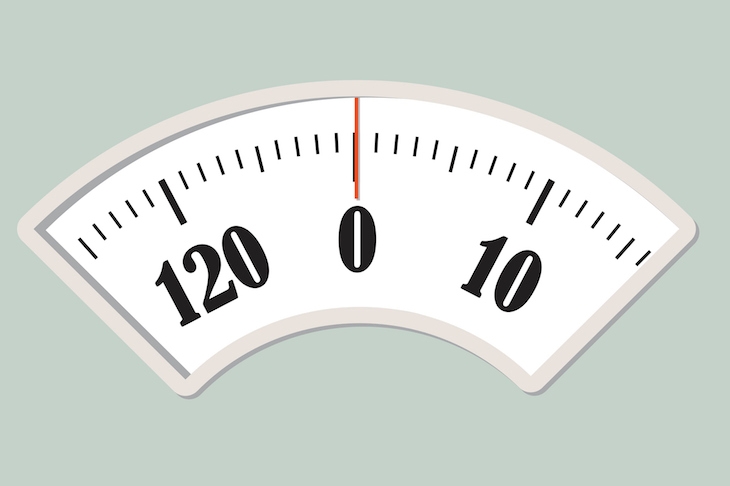I’ve become obsessed with my BMI. For those of you who don’t know, it stands for body mass index and is supposed to be a more reliable way of assessing whether you’re a healthy size than weighing yourself. It’s calculated by dividing your weight by the square of your height and is expressed as kg/m². If your BMI is under 18.5 kg/m² you’re underweight, if it’s over 25 kg/m² you’re overweight, and if it’s above 30 kg/m² you’re obese. The sweet spot is anywhere between 18.5 kg/m² and 25 kg/m².
As regular readers will know, I’m on a diet. At the beginning of the year I was nearly 13st and I’m trying to get down to 11st 7lb. So far, so good, with only 4lb left to go. But infuriatingly, my BMI stubbornly refuses to dip under 25 kg/m², so I’m still technically overweight. At least, that’s what my fancy new Nokia Body+ scale tells me. I bought this scale because, in addition to recording your BMI alongside your weight, it syncs with various apps on my phone and enables you to track your weight loss —which I’ve been doing every minute of the day. There’s one in particular called MyFitnessPal that I stare at almost continuously.
The weird thing is, when I plug my height and current weight into the BMI calculator on the NHS website, it says my BMI is 24.7 kg/m², which is just on the right side of the healthy/overweight border. But the scale still insists it’s 25.1 kg/m². Why the discrepancy? After puzzling away at this for hours, I eventually figured it out. It’s because when I entered my height into the scale I wasn’t able to include half-inch units. I’m 5ft 8.5in, but rounded this down to 5ft 8in. That vital half-inch is what makes all the difference.
When I explained this to my children, they were divided about which of the two BMI measures is the more accurate. Charlie, my nine-year-old, thinks I should have rounded up. ‘One to four, down to the floor, five to nine, up the vine,’ he recited. I was very happy with that, obviously, since if I record my height as 5ft 9in the NHS calculator puts my BMI at a healthy 24.4 kg/m². But my 14-year-old daughter Sasha was more sceptical.
‘To begin with, you’re not 5ft 8.5in,’ she said. ‘You may have been in your early twenties, but you’ve shrunk since then — that’s what happens to old people.
‘In addition, you’re about an inch taller when you first wake up than you are when you go to bed — it’s called gravity, Dad — so to be accurate, you should enter your height as 5ft 7.5in because that’s your average height over the course of the day. And if you’re rounding down — which I think you should because, you know, you’re only fooling yourself if you round up — then you should enter your height as 5ft 7in.’ She then did a quick calculation and announced that my ‘true’ BMI is 25.8 kg/m². ‘Still some way to go,’ she said ruefully.
The dependence of your BMI on your height, and the fact your height is fluid, as Sasha pointed out, does make it a less reliable measure than I first thought. Fred, my ten-year-old, made the same point when we were watching a film about a man who loses both his legs in a terrorist attack. ‘If that was you, Dad, you wouldn’t care about never being able to walk again,’ he said. ‘You’d just be worried about its impact on your BMI.’
Caroline was concerned that if I discussed my weight loss in front of the children they might develop eating disorders. In fact, it’s they who have made me manorexic. When I stand in front of a full-length mirror in my Y-fronts, I’m convinced I’m looking at the Michelin Man — even though I’ve lost more than a stone in the past six weeks.
To torture me, both Charlie and Fred gave me one of their Fruit Pastilles at QPR vs Bolton on Saturday, then insisted I look up how many calories they are on MyFitnessPal and include them in my daily food diary. I complied: they’re 13 calories a piece. Oh, how they laughed.
My home has become like the Stanford prison experiment, with my children playing the part of the sadistic guards. But by thunder it’s working. My worry now is that I won’t be able to stop at 11st 7lb. The little pitchfork-wielding devils will figure out a way of measuring my height that will mean my BMI is still in the overweight zone even then. ‘Sorry, Dad, but you’re shrinking so fast, you’re going to have to get down to 11st. No more Fruit Pastilles for you!’







Comments